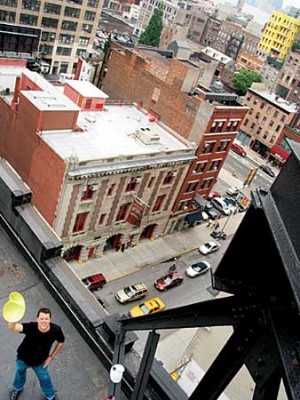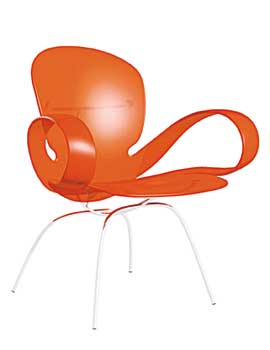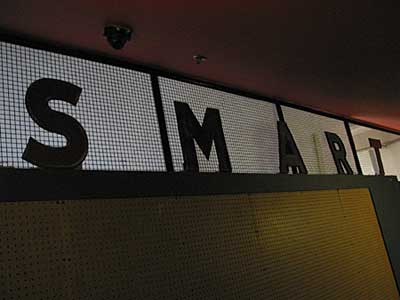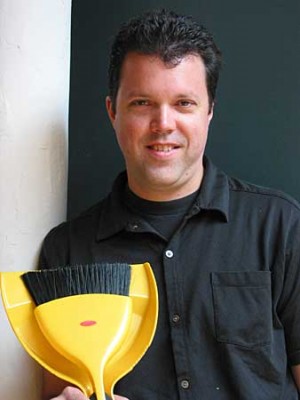Scott Henderson
Designer with a world view
The design industry is exploding in Asia, a trend that Scott Henderson, a director at the industrial design firm Smart Design in New York, sees as an enormous opportunity for cross-pollination between the East and the West.
Defining good design is something Henderson knows well. His own record in the field is impressive. He’s most noted for his line of affordable bowls and containers, moulded in thick plastic, for tableware manufacturer WOVO, and for his suction-cup bathroom supplies for OXO, a consumer products manufacturer known for its easy-to-use products.
“A great design can trigger something in your psyche that is a positive leftover from an analogy that you’ve made as a younger person. When you see it embodied in a product, you see where that came from and you get it and you smile,” Henderson says.
He leans back in a comfortable, bright-red coffee-table chair that looks like something out of the early 1970s. Henderson studied industrial design at the Philadelphia College of Art and Design, graduating in 1988. After graduation, he worked for a variety of design consultancies, designing everything from furniture and lighting to aircraft interiors. In 1993, he joined Smart Design, where he is now the director of industrial design. He also works on solo projects ranging from furniture to ceramics.
The job gives him a window on the world of design, both good and bad. Asked for an example of good design, Henderson suggests a toilet brush fashioned by French designer Philippe Starck for New York-based furniture manufacturer Heller Inc.
“It looks like a knight’s lance with a conical shape that covers your hand,” Henderson says. The shape conjures a positive reference from childhood, he says, and “when you see it embodied, you recognise it and there is an intellectual response taking place.”
He quickly draws Starck’s brush in a few precise lines. “You have to create analogies to things that people have seen before, and you have to recombine them in ways that are clever, so that the reaction is a universal ‘Aha! Look how cool that is.’
“But sometimes it’s not so obvious as the knight’s lance,” Henderson says. “Sometimes it’s more related to the ways two forms come together or to some kind of interesting sculptural composition – and that could still be related to this analogy that your mind is making to something else, but it’s much more abstract, like a piece of artwork. You want to take a known convention and really twist it and transcend it.”
Smart Design specialises in mass-produced consumer products, many of them manufactured in Asia. “When you’re talking about millions of parts, usually you have to manufacture them where you are able to improve your margins,” he says.
But profit margins are only one factor in the company’s design work. The expectations for a product from Smart Design, he says, are fourfold:
1. It will sell extremely well.
2. It will meet the needs of the masses.
3. It will be accessible in price.
4. It will accomplish 1-3 and still end up in a museum, which is the opposite of what usually happens.
Getting smart
Smart Design is located on the top floor of an old warehouse building in Soho. The company’s open office space, where the only light sources seem to be large skylights and the glow from numerous computer screens, has a relaxed and collaborative atmosphere.
No walls define personal space in this loft, where everything from kitchenware to photo printers is designed. Small personal desks ring the perimeter, but they seem to be a formality, because Smart Design has designated workstations for the various projects people work on.
“Each project gets its own bay, and we try to keep them there as much as possible,” says Henderson. “Then the designer can come to the project and know what’s going on, rather than having it scattered all over the place.” Each project bay contains everything that has to do with the particular project, including large storage shelving units and communal computers facing the hallway, which invites interaction with passers-by.
Smart Design, because of its manufacturing ties with Asia, is in touch with the surge of interest in design there. Henderson says the movement is to be expected – there’s plenty of historical precedent for it.
“This is the result of the various countries in the region growing increasingly stronger economically and pushing their manufacturing offshore,” he says. As nations prosper, the cost of labour increases. Manufacturing tasks typically move to regions with lower labour costs. And where manufacturing moves, an interest in design follows.
When Japan became fully developed economically, the Japanese pushed manufacturing to Taiwan, Henderson says, and as Taiwan matured industrially, it pushed manufacturing to China. He draws countries and arrows on his notepad.
“The reason these countries continue to flourish is that they always innovate,” he says. “Now there is a very strong interest in design developing in that region. This is something that everyone involved with design should be aware of.”
Indeed, the interest in design is surging in countries such as Taiwan, China, South Korea and Thailand. In Taiwan alone, more than 20 colleges and universities have industrial design departments, and about 2,000 industrial designers graduate every year.
But Henderson notes that, contrary to what one might expect, there is no specific trend towards design with an Asian influence. Quite the opposite: Modern industrial design in Asia tends to mirror industrial design of the West.
A globalised economy and rapid global information-sharing is giving rise to a global aesthetic, he says, where the look of design is becoming more and more universal and no longer something that only applies to one demographic region. “What you will notice in the future is good design versus bad design,” he says. “In 10 years you will no longer think of American versus British versus Italian design. Instead the question will be: ‘Is it good or is it bad?’”
Riding the tiger
Microsoft, Hewlett-Packard, Motorola and Dell are all setting up research and manufacturing centres in Taiwan and China. At the same time, the Taiwanese government is building large research and development centres that offer research, design and manufacturing service within the same facility. For many designers in the West, this is a cause for great concern.
Henderson sees both sides of the argument. On the one hand, he says, it is logical to put design close to the factory level. But it can be argued on the other hand that such an arrangement puts too much distance between the design process and the end user. Immersing designers in the culture for which they are designing, rather than in a factory environment, may stimulate creativity, he suggests.
“Maybe it makes just as much sense to have a design firm smack in the middle of Manhattan, like Smart Design, because here we are, surrounded by people, consumers and culture, and all these influences that help us generate great design,” Henderson says.
If the designers were closeted in a factory in an industrial zone, “surrounded by injection-moulding machines,” he says, “all we’d be thinking about would be how to make the product as fast as possible so it can be produced.”
Henderson sees Asian interest in design as a great opportunity, and says he believes that international design firms should be seeking collaborative projects with the fast-growing Asian businesses. The presence of large international development centres in the region can create new opportunities for the exchange of ideas and knowledge between Asia and the rest of the world, he says.
“There is a growing need for designers because there is a growing need for new products,” Henderson says. In design, as in other fields, “the more the merrier” is the rule. “McDonald’s doesn’t worry so much about Burger King building a restaurant next door to them, because the increase in traffic is going to benefit them – they will feed off of their competitors.”
Henderson laughs and leans far back into his bright-red chair. He doesn’t come across as someone who is very worried about the future.





